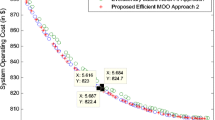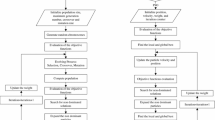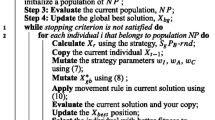Abstract
The distribution of individuals in a population significantly influences convergence to global optimal solutions. However, determining how to maximise decision space information, which benefits convergence, is disregarded. This paper proposes a type of multi-objective evolutionary algorithm based on decision space partition (DSPEA), and designs the sphere initialisation strategies, initialisation method of individuals in each sphere, updating approach for the centroid, radius, and individuals of a hypersphere, and information sharing mechanism among spheres. The decision space in the DSPEA framework is explicitly divided into several hyperspheres. The non-dominated sorting genetic algorithm II is employed to implement each evolution of each hypersphere. An improvement approach related to the information sharing of the spheres is used to produce the future motions of the spheres by adopting particle swarm optimisation. Twelve problems were used to test the performance of DSPEA, and extensive experimental results show that DSPEA performs better than six state-of-the-art multi-objective evolutionary algorithms. Finally, DSPEA is used to optimise a hybrid power system. The results of the simulation optimisation tests on the parameters of the control strategy and the drive system for hybrid electric vehicles demonstrate that the proposed approach can obtain a set of improved solutions with low fuel consumption and pollutant emission.





Similar content being viewed by others
References
Bui LT, Abbass HA, Essam D (2009) Localization for solving noisy multi-objective optimization problems. Evol Comput 17(3):379–409
Cheng P, Lee I, Lin CW, Pan JS (2016) Association rule hiding based on evolutionary multi-objective optimization. Intell Data Anal 20(3):495–514
Coello CC, Lechuga MS (2002) Mopso: a proposal for multiple objective particle swarm optimization. In: Proceedings of the 2002 congress on evolutionary computation, 2002. CEC’02, vol 2. IEEE, pp 1051–1056
Corne DW, Jerram NR, Knowles JD, Oates MJ et al (2001) Pesa-ii: region-based selection in evolutionary multiobjective optimization. In: Proceedings of the genetic and evolutionary computation conference (GECCO2001, Citeseer)
Deb K (2014) Multi-objective optimization. In: Search methodologies, Springer, pp 403–449
Deb K, Jain H (2014) An evolutionary many-objective optimization algorithm using reference-point-based nondominated sorting approach, part i: solving problems with box constraints. IEEE Trans Evol Comput 18(4):577–601
Deb K, Jain S (2002) Running performance metrics for evolutionary multi-objective optimization
Deb K, Pratap A, Agarwal S, Meyarivan T (2002a) A fast and elitist multiobjective genetic algorithm: Nsga-ii. IEEE Trans Evol Comput 6(2):182–197
Deb K, Thiele L, Laumanns M, Zitzler E (2002b) Scalable multi-objective optimization test problems. In: Proceedings of the 2002 congress on evolutionary computation, 2002. CEC’02, vol 1. IEEE, pp 825–830
Dioṡan L, Andreica A (2015) Multi-objective breast cancer classification by using multi-expression programming. Appl Intell 43(3):499–511. doi:10.1007/s10489-015-0668-8
Eskandari H, Geiger C, Lamont G (2007) Fastpga: a dynamic population sizing approach for solving expensive multiobjective optimization problems. In: Evolutionary multi-criterion optimization. Springer, pp 141–155
Gacto MJ, Alcalá R, Herrera F (2012) A multi-objective evolutionary algorithm for an effective tuning of fuzzy logic controllers in heating, ventilating and air conditioning systems. Appl Intell 36(2):330–347
Giel O, Lehre PK (2010) On the effect of populations in evolutionary multi-objective optimisation. Evol Comput 18(3):335–356
Guanci Y, Shaobo L, Jinglei Q, Guanqi G, Yong Z (2012a) Multi-objective optimization of hybrid electrical vehicle based on pareto optimality. Shanghai Jiaotong Daxue Xuebao/J Shanghai Jiaotong Univ 46(8):1297–1303
Guanci Y, Shaobo L, Xianghong T, Jinglei Q, Yong Z (2012b) Control strategy parameter analysis of parallel hybrid electric vehicles based on multiindex orthogonal experiment. J Comput Appl 32(11):3047–3053
Guanci Y, Shaobo L, Yong Z (2012c) Probability analysis of capturing specific objects in stratified sampling model. J Comput Appl 32(08):2209–2211
Guanci Y, Shaobo L, Yong Z, Zhengchao P (2012d) Multi-objective evolutionary algorithm based on decision space partition. Huazhong Keji Daxue Xuebao (Ziran Kexue Ban)/J Huazhong Univ Sci Technol (Nat Sci Edn) 12:49–54
Kennedy J (2011) Particle swarm optimization. In: Encyclopedia of machine learning. Springer, pp 760–766
Kukkonen S, Lampinen J (2005) Gde3: the third evolution step of generalized differential evolution. In; 2005 IEEE congress on evolutionary computation, vol 1. IEEE, pp 443–450
von Lücken C, Barán B, Brizuela C (2014) A survey on multi-objective evolutionary algorithms for many-objective problems. Comput Optim Appl 58(3):707–756
Maoguo G, Licheng J, Dongdong Y, Wenping M (2009) Research on evolutionary multi-objective optimization algorithms. Ruan Jian Xue Bao/J Softw 20(2):271–289
Markel T, Brooker A, Hendricks T, Johnson V, Kelly K, Kramer B, OKeefe M, Sprik S, Wipke K (2002) Advisor: a systems analysis tool for advanced vehicle modeling. J Power Sour 110(2):255–266
Nebro AJ, Durillo JJ, Luna F, Dorronsoro B, Alba E (2009) Mocell: a cellular genetic algorithm for multiobjective optimization. Int J Intell Syst 24(7):726–746
Neyman J (1934) On the two different aspects of the representative method: the method of stratified sampling and the method of purposive selection. J R Stat Soc 97(4):558–625
Robič T, Filipič B (2005) Demo: differential evolution for multiobjective optimization. In: International conference on evolutionary multi-criterion optimization. Springer, pp 520– 533
Schott JR (1995) Fault tolerant design using single and multicriteria genetic algorithm optimization. Tech. rep., DTIC Document
Wang Y, Li HX, Yen GG, Song W (2015) Mommop: multiobjective optimization for locating multiple optimal solutions of multimodal optimization problems. IEEE Trans Cybern 45(4):830–843
Weisstein EW (2015) Spherical coordinates. http://mathworld.wolfram.com/SphericalCoordinates.html, accessed: 2015-09-30
Yang XS (2013) Multiobjective firefly algorithm for continuous optimization. Eng Comput 29(2):175–184
Zhang Q, Li H (2007) Moea/d: a multiobjective evolutionary algorithm based on decomposition. IEEE Trans Evol Comput 11(6):712–731
Zitzler E, Deb K, Thiele L (2000) Comparison of multiobjective evolutionary algorithms: empirical results. Evol Comput 8(2):173–195
Zitzler E, Laumanns M, Thiele L et al (2001) Spea2: improving the strength pareto evolutionary algorithm. In: Eurogen, vol 3242, pp 95–100
Acknowledgments
This work has been supported by National Natural Science Foundation of China (61540066 and 51475097), Science and Technology Foundation of Guizhou Province (R[2015]13, JZ[2014]2004, JZ[2014]2001, ZDZX[2013]6020, G[2014]4001, ZDZX[2014]6021), Science and Technology Foundation of Guizhou Province (J[2013]2127), Torch Program projects of Guizhou Province ([2013]5051), and National Key Technology Support Program of China (2012BAH62F00).
Author information
Authors and Affiliations
Corresponding author
Rights and permissions
About this article
Cite this article
Yang, G., Zhang, A., Li, S. et al. Multi-objective evolutionary algorithm based on decision space partition and its application in hybrid power system optimisation. Appl Intell 46, 827–844 (2017). https://doi.org/10.1007/s10489-016-0864-1
Published:
Issue Date:
DOI: https://doi.org/10.1007/s10489-016-0864-1




